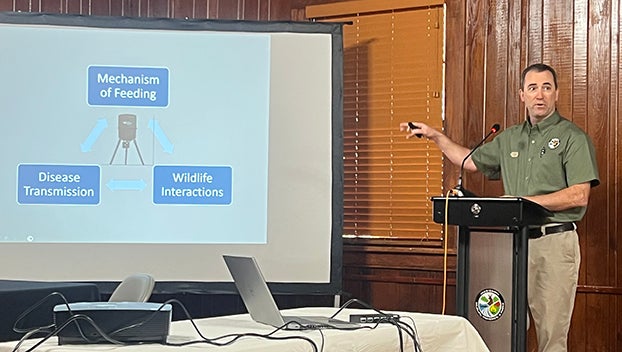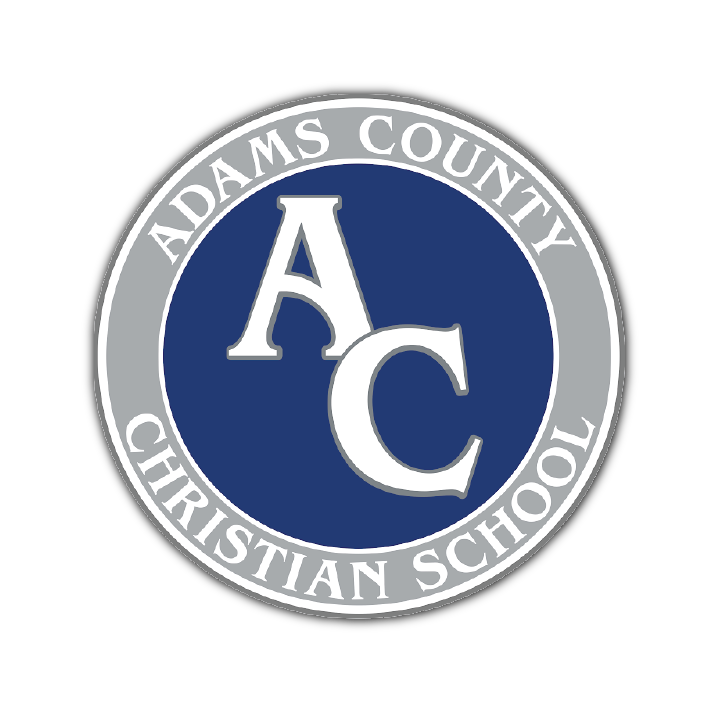Walsh gives summary of disease management to commissioners, public
Published 1:17 pm Friday, March 22, 2024

- MDWFP Wildlife Bureau Chief of Staff Russ Walsh gives a summary about the role of supplemental feeding and its impact on animal behavior. (Hunter Cloud | The Daily Leader)
|
Getting your Trinity Audio player ready...
|
MCCOMB — Wildlife Bureau Chief of Staff Russ Walsh gave a summary about disease management as it pertains to supplemental feeding Thursday morning. Mississippi Department of Wildlife, Fisheries and Parks commissioners and the public had an opportunity to learn more about the role feeding plays in wildlife diseases.
The educational session started at 9 a.m. and ended by 9:55 a.m. at Percy Quin State Park and can be watched in its entirety on the MDWFP website.
Commissioner Leonard Bentz opened the session by first stating they had challenged their biologists to put together the informative session and made it clear the educational session would be livestreamed. Last year’s educational sessions on wild turkeys was recorded and uploaded at a later date but not live streamed.
Walsh said the information gathered for the presentation came from colleagues at other wildlife agencies and Universities. When supplemental feeding was first legalized, Walsh said the statute had a provision that required MDWFP to study how it impacts wildlife health and risk of disease. Supplemental feeding was first legalized in 2007.
“We are not talking about the feed itself today. It is important to understand we are talking about the mechanism of feeding,” Walsh said. “Placing feeders on the landscape and concentrating deer unnaturally. It brings animals to a feeding site. Not the feed but the mechanism. We summarized wildlife interactions and the disease transmission risk. We also found research about CWD prions on the feeder itself.”
Natural deer foraging behavior requires significant time and energy. Deer aren’t going to the same specific location every day but covering a broad geographic area to find seasonal sources of food. In an artificial foraging setting, feeding from stationary feeders, which must be above ground and covered, brings animals to the same location day in and day out.
Research from Mississippi State University shows deer select for supplemental feeding sites on a weekly basis more frequently than they did food plots. Michigan State conducted similar research and found similar results.
“Those animals become habituated which is completely not natural if you look at normal behavior of animals,” Walsh said.
Proponents of feeding point to improved wildlife health, higher reproductive capacity, growth, harvest and viewing opportunities as reasons to supplementally feed. Walsh said research shows a constant availability of food creates an unnatural environment and causes frequent interactions with wildlife species.
One picture in the powerpoint slide showed deer and raccoons all at the same feeder at the same time. Another picture in the powerpoint showed social groups of does were close together whereas they otherwise would not have interacted together.
“Research by MSU shows those doe family groups are distinct on the landscape. Deer may live in proximity but in feeder sites this breaks down,” Walsh said.
Disease transmission
Feeding concentrates animals which allows for diseases to potentially spread from species to species. The concentration around feeders causes deposits of feces, urine and saliva to be greater than in the natural food sources, Walsh said. Deer fecal piles are two times greater at feed sites vs unfed sites and raccoon fecal piles are four times greater at feed sites vs unfed sites.
It is a problem for disease management because the disease vectors are thus concentrated.
He acknowledged the conversation has been about Chronic Wasting Disease but a broader suite of diseases needs to be a part of the conversation.
- Aflatoxicosis is a fungi on feed such as corn where toxins are produced and when ingested poses a risk to wild birds such as turkeys and quail
- Avian pox is a viral infections which causes liasons on turkeys heads and could impact the immune system
- Bovine tuberculosis is a bacteria which causes respiratory problems and rare occasions was passed to humans.
- Brucellosis causes reproductive problems in cattle
- Coccidiosis is a parasite which gets into an animal’s digestive system
- Leptospirosis is a bacteria which can be passed to humans from animal urine
- Toxoplasmosis is a parasitic disease which causes abortion and reproductive failure in cervids and other similar mammals
According to the Center for Disease Control, more than 40 million humans carry Toxoplasmosis but few have symptoms because the immune system keeps the parasite from causing illness.
Research by Mississippi State found Coccidia and nematode concentrations were greater at feed sites by three and two times.
MSU found CWD on feeders in Benton and Marshall Counties in a recent study. The same study found raccoons were carrying CWD prions on their paws.
“There is a risk of movement of disease agents and the risk of contact of disease agents may be carried to other sites,” Walsh said. “We fear the raccoons are picking up the prions and depositing the prions at new feeders.”
Research conducted at MSU found 40 percent of supplemental feeding site visitors were raccoons followed by deer at 25 percent.
Walsh said outside of disease management there is a need to look into the question of if supplemental feeding is benefiting turkeys and raccoons who are potential nest predators of turkeys. Research has already looked at the effect of concentration degrading habitat and how it affects the movement of wildlife which in turn could have an impact on harvest success.
MSU research on deer movement in the Black River Region that was recently published found deer visited feeder sites more often at night. Nearly 36 percent of visits occurred between 6 p.m. to 12 a.m. and 31 percent occurred between 12 a.m. to 6 am. The research suggests hunters may improve chances of seeing adult bucks if they hunt in locations between feeders and bedding sites. Deer were 10 times more likely to visit sites with a feeder and five times more likely to visit sites with food plots than areas of natural vegetation.
Disease management is still the strongest argument for banning supplemental feeding. MSU’s research found the adult bucks were 60 percent more likely to interact at a feeder than a food plot and 300 percent more likely to interact at a feeder than a natural area on the landscape. The paper concludes “With multiple adults bucks interacting at feeders it is distinctly possible that the use of feeders will contribute to increases in the spread and or prevalence of diseases that are transmitted through direct contact with infected individuals such as chronic wasting disease.” CWD is again one of the reasons why a statewide supplemental feed ban is being discussed.
“Wildlife diseases are a significant conservation issue right now,” Walsh said. “What is the risk for humans? Multiple of the diseases are zoonotic and could be picked up by us. Wildlife can be concentrated enhancing disease risk. Not talking about the other factors, the risk is greater than the benefits of feeding.”
He shared a quote with the commission from a Canadian research synthesis paper on the effects of supplemental feeding. “However, given the on-going challenges of addressing wildlife disease issues and the role of baiting, it seems unlikely that diseases will be successfully eradicated or even managed while widespread baiting and feeding is permitted.” Walsh said the quote was the final sentence of the paper.
The summary was just the start of an important conversation. Check back for additional stories sharing what MDWFP Commissioners and the public discussed following the session.






